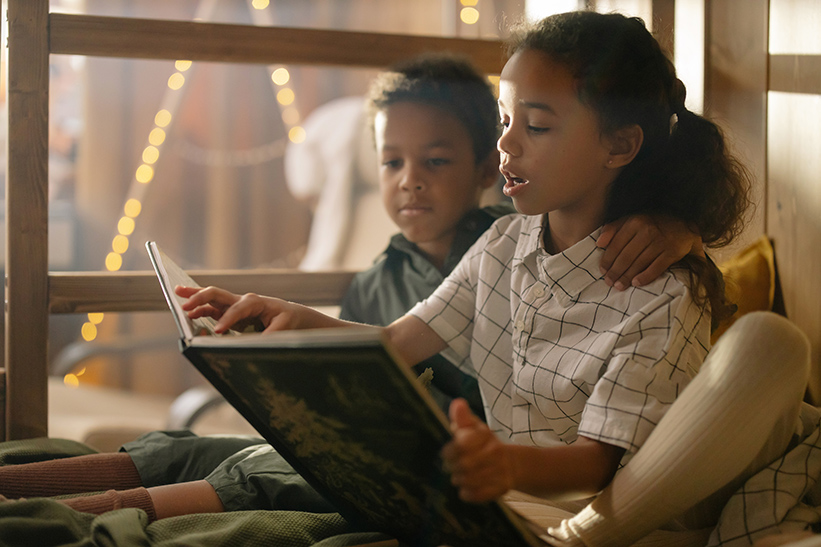Prompting sibling bonding is important but can be challenging. This blog gives tips for parents to promote sibling bonding while keeping in mind the needs of your children. You shouldn’t force too much togetherness with siblings and you must provide time for unstructured play. It is also important to keep in mind that each child develops at their own pace. The first step to promoting sibling play is to collect a list of items that each child prefers to play with. After gathering your list, set up the environment to promote play. Setting up the environment is very important. Depending on the stage of play that your children are in, you want to set up the environment so that they are engaged in the same activity without other preferred distractions. For example, siblings can engage in parallel play while coloring. You would need to remove all other toy options and set up the table with markers and preferred pictures for each child. For associative play, set up blocks and remove all other toy options so that they can engage in the same activity next to each other on the floor. For social play, remove all other toy options and set up a board game, card game, ball game that requires turn taking and sharing.
ONLOOKER PLAY (1-2 years)
Onlooker play starts during toddler years, but can happen at any age. This stage is when children watch others play. The child who is looking at the other children, but there is no effort to join the play. This may happen when a child is shy, or unsure of the rules, or is hesitant to join the game.
PARALLEL PLAY (2-3 years)
Parallel play is usually found with toddlers, although it happens in any age group. Parallel play starts when children begins to play side-by-side with other children without any interaction. Even though it seems like they are not interacting, they are paying attention to each other. This is the beginning of the desire to be with other children. This stage really starts to lay the groundwork for the more complex social stages of play.

ASSOCIATIVE PLAY (3-4 years)
At around three to four years of age, they eventually become more interested in the other children rather than the toys. At some point, a child will start interacting more with the other child they are playing with; this is called associative play. They start asking questions and talking about the toys and what they are making. This is the beginning of understanding how to get along with others. During associative play, children within the group have similar goals (for example: building a tower out of blocks). However, they don’t set rules and there’s no formal organization.
SOCIAL PLAY (4 and up)
Children will really begin to socialize starting around three or four. They begin to share ideas and toys and follow established rules and guidelines. They play shop and figure out who will play what role. They can work together to build something or maybe play a simple game together. This is really where a child learns and practices social skills, like cooperating, being flexible, taking turns, and solving problems.
As children proceed in the stages of play, their play becomes more complex and involves more and more interacting with others. For children to practice social skills like cooperating, compromising and problem solving, the best way to do that is to let them play. They’ll remember the rhythms and melodies of social interactions much more smoothly if we allow them the time and space to play.
Suggested activities to promote sibling play:
- water play
- bubbles
- balloons
- magnetic tiles
- playdoh and cutters (not recommended for children that mouth non-edible items)
- sand (not recommended for children that mouth non-edible items)
- cause and effect toys
- ball pit
- cars and tracks
- trains and tracks
- books (touch and feel, flip tabs, pop ups, sing along)
- and more!
References:
Parten, M.B. (1932). Social participation among preschool children. Journal of Abnormal and Social Psychology, 27(3), 243-269.
Rymanowicz. (2015). The power of play – part : Stages of play. Retrieved from http://msue.anr.msu.edu/news/the_power_of_play_part_1_stages_of_play

Blue Bird Day fosters socialization, sensory regulation, and pre-academic learning in children ages 2-7 years in therapeutic rotations that simulate preschool and kindergarten settings. Our compassionate therapists practice a relationship-based and family-centered approach, provide parent training, and collaborate on goals and individualized intensive treatment plans for your child.
We believe in a collaborative and multi-disciplinary team approach to therapy. A team of occupational therapists, speech-language pathologists, dietitians, developmental therapists, behavioral therapists, physical therapists, and therapeutic assistants are created for each child to ensure child and family are fully supported and the best possible results are achieved.
Options for individualized, group and virtual therapy sessions are available as well.
Want to learn more or you have a specific question? Feel free to connect with us here!



